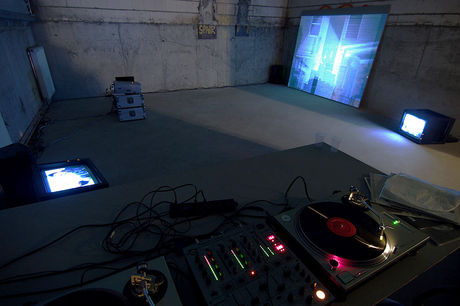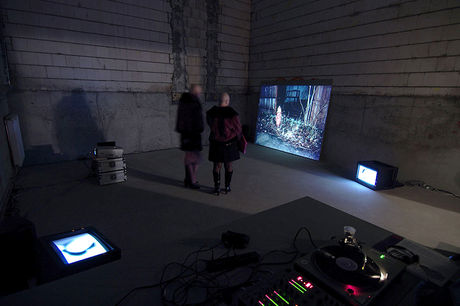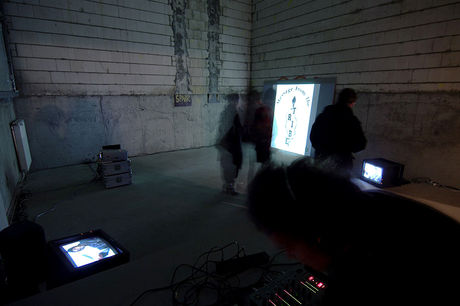Michael E. Smith
KOW ISSUE 3
Detroits' Post-Fordism
Michael E. Smith
Mar 27 - 29, 2009
- See more at: http://www.kow-berlin.info/issues/kow_issue_3#sthash.J3TFnmwC.dpufMichael E. Smith
Mar 27 - 29, 2009
KOW ISSUE 3
Detroits' Post-Fordism
Michael E. Smith
Mar 27 - 29, 2009
- See more at: http://www.kow-berlin.info/issues/kow_issue_3#sthash.J3TFnmwC.dpufMichael E. Smith
Mar 27 - 29, 2009
Mar 27 - 29, 2009
In the seventies, the Detroit Jazz Label ‘Tribe’ was one of the most significant political music communities of the black liberation movement in the US. During three successive nights, Nikolaus Oberhuber plays a program out of the eight albums edited by the small label between 1972 and 1976. In parallel we show videos by Michael E. Smith (born 1977), as well as photos shot in Detroit within the past days. The images display the current degree of urban destruction, kicked off by the decline of the car industries and the riots of 1967, which continuously splits the city in black and white, rich and poor.
After the American civil rights movement and its achievements, ‘Tribe’ gave a voice to the new political self-consciousness of black US citizens and was exemplary for its social self organization – but it also mirrored battered hopes for social conciliation, only some years after the riots and the assassinations of J.F. Kennedy and M.L. King. Affirming African roots and tribe culture, ‘Tribe’ emancipated its community people from cultural and economic paternalism, at the same time, however, helped to increase social segregation. “Tribe was a band, a music company and a magazine publication. It was a movement of black pride and self-determination” (Phil Ranelin). Its Jazz was resistive, imaginative and resolute. It inspired more than a generation.
In the thirties, American photographer Walker Evans gave shape to the image of poverty caused by the economic crisis of 1929. Michael E. Smith keeps record of the dark and shattered neighborhoods typical for the enduring crisis of Detroits’ Postfordism. The degenerated houses are ruins of the welfare state that ‘Fordism’ had promised. The state of the city recalls the unredeemed assurance that technical and economic progress would be for all. Apparently it is not. Detroit is a humanitarian disaster of the West. A monument of the cancelled social contract between workers and the capital, on which the ‚New Deal‘ was once agreed.
Smith considers his images from the very present as ‚blind spots‘: “Because the actual here becomes a force full on into darkness, doubt, and disbelief. This is in a way how all of this can be experienced as relief. You simply can’t speak/ you’re blank. We are not able to see these photos. They don’t exist.“ Smiths short videos (2007/2008) stress the psychosocial dimension of his artistic practice. They dramatize casual observations through filmic isolation, slowdown and repetition. Brief moments and gestures take an uneasy and threatening turn to recall the existential dimension of ‘the everyday’. So did the first ‘Tribe’ records, with titles like: „What we need“, „Where am I?” and “Time is Now”.
Concept and production: Alexander Koch and Nikolaus Oberhuber. Text and Photos: Alexander Koch
KOW ISSUE 3 was reinstalled at ABC BERLIN in September 2009 and at MÄRKISCHES MUSEUM WITTEN in the exhibition "Schach Matt", curated by Markus Draper and Aleksander Wawrzyniak, Jun 30–Aug 26, 2012
After the American civil rights movement and its achievements, ‘Tribe’ gave a voice to the new political self-consciousness of black US citizens and was exemplary for its social self organization – but it also mirrored battered hopes for social conciliation, only some years after the riots and the assassinations of J.F. Kennedy and M.L. King. Affirming African roots and tribe culture, ‘Tribe’ emancipated its community people from cultural and economic paternalism, at the same time, however, helped to increase social segregation. “Tribe was a band, a music company and a magazine publication. It was a movement of black pride and self-determination” (Phil Ranelin). Its Jazz was resistive, imaginative and resolute. It inspired more than a generation.
In the thirties, American photographer Walker Evans gave shape to the image of poverty caused by the economic crisis of 1929. Michael E. Smith keeps record of the dark and shattered neighborhoods typical for the enduring crisis of Detroits’ Postfordism. The degenerated houses are ruins of the welfare state that ‘Fordism’ had promised. The state of the city recalls the unredeemed assurance that technical and economic progress would be for all. Apparently it is not. Detroit is a humanitarian disaster of the West. A monument of the cancelled social contract between workers and the capital, on which the ‚New Deal‘ was once agreed.
Smith considers his images from the very present as ‚blind spots‘: “Because the actual here becomes a force full on into darkness, doubt, and disbelief. This is in a way how all of this can be experienced as relief. You simply can’t speak/ you’re blank. We are not able to see these photos. They don’t exist.“ Smiths short videos (2007/2008) stress the psychosocial dimension of his artistic practice. They dramatize casual observations through filmic isolation, slowdown and repetition. Brief moments and gestures take an uneasy and threatening turn to recall the existential dimension of ‘the everyday’. So did the first ‘Tribe’ records, with titles like: „What we need“, „Where am I?” and “Time is Now”.
Concept and production: Alexander Koch and Nikolaus Oberhuber. Text and Photos: Alexander Koch
KOW ISSUE 3 was reinstalled at ABC BERLIN in September 2009 and at MÄRKISCHES MUSEUM WITTEN in the exhibition "Schach Matt", curated by Markus Draper and Aleksander Wawrzyniak, Jun 30–Aug 26, 2012



